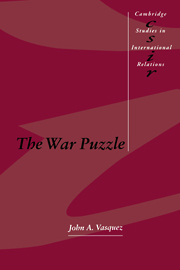Book contents
- Frontmatter
- Contents
- Preface
- PART I PRELIMINARIES
- PART II THE ONSET AND EXPANSION OF WARS OF RIVALRY
- 4 TERRITORIAL CONTIGUITY AS A SOURCE OF CONFLICT LEADING TO WAR
- 5 THE REALIST ROAD TO WAR
- 6 THE DOMESTIC PREREQUISITES OF WARS OF RIVALRY
- 7 EXPLAINING WORLD WAR: ITS SCOPE, SEVERITY, AND DURATION
- 8 PEACE
- 9 CONCLUSION: SOLVING THE PUZZLE OF WAR
- Appendix: A propositional summary
- Notes
- References
- Index
- Titles in series
9 - CONCLUSION: SOLVING THE PUZZLE OF WAR
Published online by Cambridge University Press: 07 December 2009
- Frontmatter
- Contents
- Preface
- PART I PRELIMINARIES
- PART II THE ONSET AND EXPANSION OF WARS OF RIVALRY
- 4 TERRITORIAL CONTIGUITY AS A SOURCE OF CONFLICT LEADING TO WAR
- 5 THE REALIST ROAD TO WAR
- 6 THE DOMESTIC PREREQUISITES OF WARS OF RIVALRY
- 7 EXPLAINING WORLD WAR: ITS SCOPE, SEVERITY, AND DURATION
- 8 PEACE
- 9 CONCLUSION: SOLVING THE PUZZLE OF WAR
- Appendix: A propositional summary
- Notes
- References
- Index
- Titles in series
Summary
Before something is understood, it appears both more complex and simpler than it actually is.
It is now time to put the pieces of the puzzle together. Each of the previous chapters has sifted through the evidence trying to distinguish real clues from false leads. With major parts of the puzzle completed and all the pieces laid out on the table, it remains to be seen if the various parts can be fitted together to make a whole. This is the way in which scientific theory can be inductively constructed.
Induction involves generalization from a few cases to a population. True induction, however, is not confined simply to stating that the findings from some cases apply to many, it involves deriving general principles from a few instances. It is these general principles that are used to integrate findings and resolve puzzles so that a coherent explanation of the phenomenon is provided. This chapter attempts to provide such an explanation by weaving together the various threads of analysis in the previous chapters into a concise statement of the factors that bring about the onset and explanation of wars of rivalry in the modern global system.
The analysis is guided by two assumptions, one methodological and the other theoretical. Methodologically, it is assumed that there are several causal paths to war. This book has attempted to delineate one of them, i.e. the path to war resulting from disputes over territory and the adoption of the foreign policy practices of power politics between relative equals.
- Type
- Chapter
- Information
- The War Puzzle , pp. 292 - 308Publisher: Cambridge University PressPrint publication year: 1993



